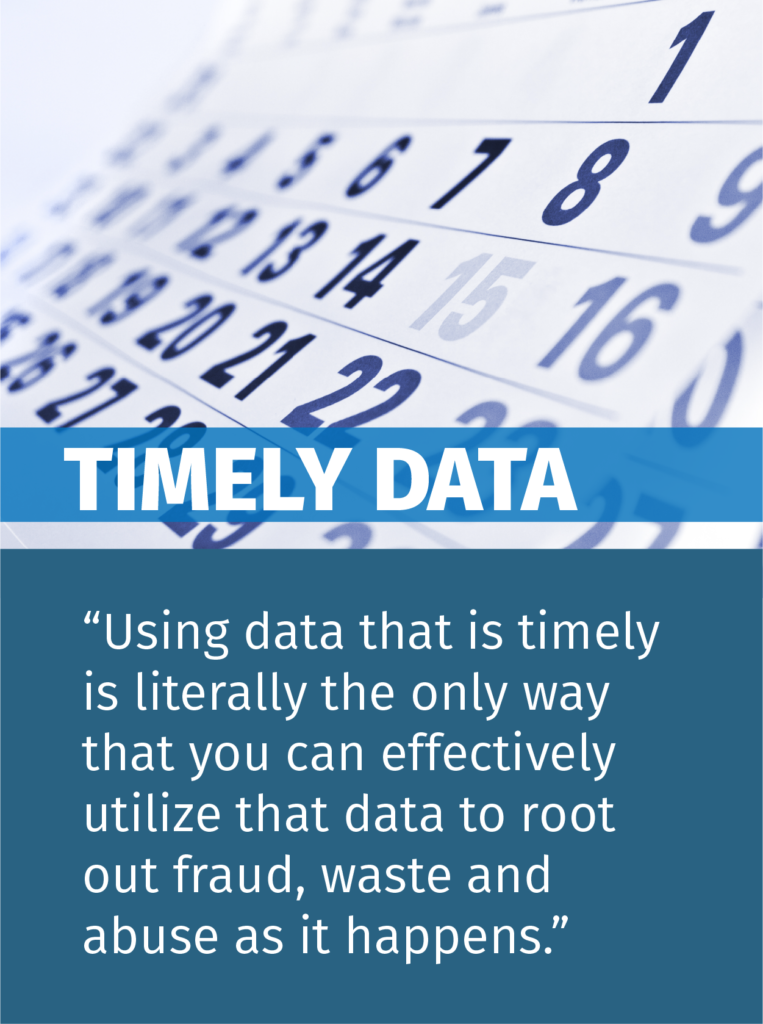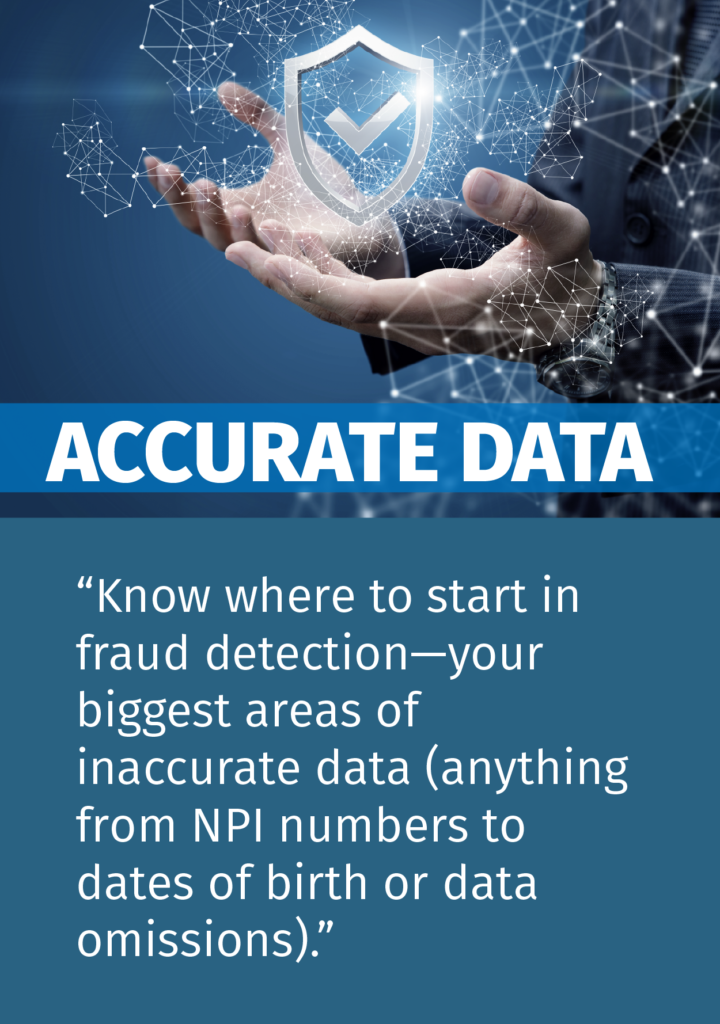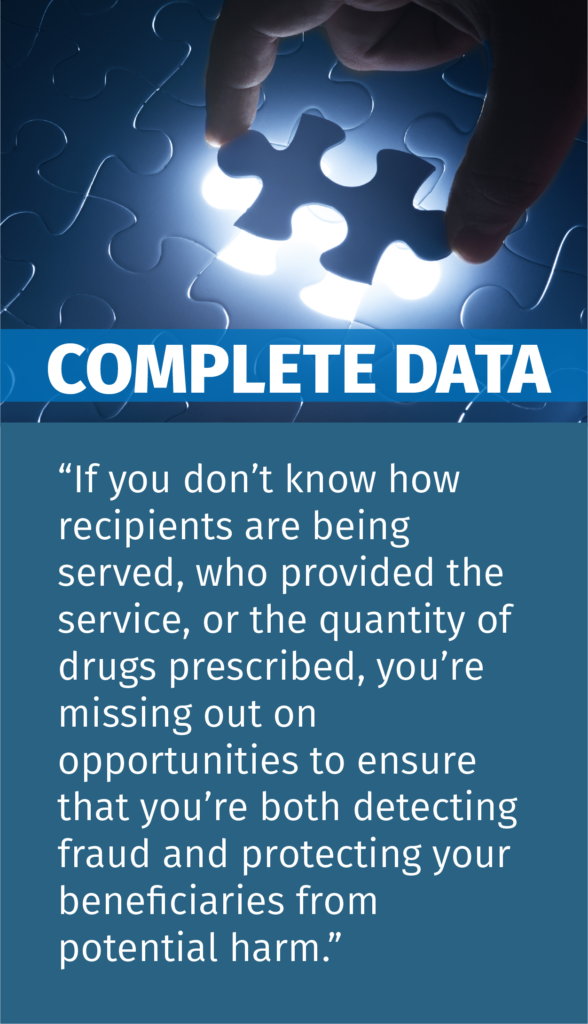How Program Integrity Professionals Can Unlock the Mystery to Improving Encounter Data
 In the seven years that I spent as Program Integrity Director at the West Virginia Bureau for Medical Services, I’ve experienced many of the compliance challenges agencies face as they aim to stay compliant via fraud, waste and abuse identification, recoveries and referrals.
In the seven years that I spent as Program Integrity Director at the West Virginia Bureau for Medical Services, I’ve experienced many of the compliance challenges agencies face as they aim to stay compliant via fraud, waste and abuse identification, recoveries and referrals.
In my current role at a company that has a national presence related to Medicare and Medicaid program integrity, I see first-hand how much program integrity professionals are grappling with an increasingly common challenge: effectively securing and managing source data—encounter data submission. I’ll be honest—they are all struggling. As a matter of fact, just a few months ago, the Office of Inspector General (OIG) reviewed data on Medicaid Managed Care Payments to providers and came to the same conclusion.
In this blog, I’ll walk you through common pitfalls of detecting fraud when encounter data isn’t timely, complete or accurate. And I’ll share quick strategies to help you feel less overwhelmed and hone in more effectively on which problems to tackle first.
Why an apple-to-apples approach to encounter data is critical for program integrity and fraud detection
 As a program integrity professional, while you already know why taking an apples-to-apples approach to managed care encounter data is important, do you also know how to become confident in a methodical approach that yields results?
As a program integrity professional, while you already know why taking an apples-to-apples approach to managed care encounter data is important, do you also know how to become confident in a methodical approach that yields results?
As a program integrity professional, my challenge, as I imagine yours might be, was managing the gargantuan responsibilities that come with having to capture all of this data (including fee-for-service and its obvious effects on encounter data) as well as harmonizing the data coming in from so many different sources—including the many contractors and even their own subcontractors who possessed much of that data.
While each Managed Care Organization (MCO) has a different structure, the one thing MCOs all have in common is a contract which outlines specific requirements mandating certain activities, deliverables and performance expectations. And there-in lie three common pitfalls in detecting fraud—timeliness, accuracy and completeness.
Encounter data pitfall #1: What happens to fraud detection in your agency when data is not timely?
 As you know, to be able to manage encounter data effectively enough to find waste, fraud or abuse within your agency, the data must be timely. Specifically, it should be submitted on a monthly basis, as most contracts require. That is literally the only way that you, in your role as a program integrity professional, can effectively utilize that data to root out fraud, waste and abuse as it happens.
As you know, to be able to manage encounter data effectively enough to find waste, fraud or abuse within your agency, the data must be timely. Specifically, it should be submitted on a monthly basis, as most contracts require. That is literally the only way that you, in your role as a program integrity professional, can effectively utilize that data to root out fraud, waste and abuse as it happens.
Three strategies for improving timeliness of encounter data:
For most of us, the hardest part of ensuring that the data is timely is simply knowing where to start. To do that, focus on the greatest areas of concern to you. Here are some strategies to help you:
1. Do you have contractual requirements to mandate data submission? If not, then consider making recommendations by adding contract language that encourages compliance and shows clear evidence of what that means.
2. Give your contractors an opportunity to improve before implementing penalties. Providing technical assistance allows both you and your contractors to understand the underlying root causes behind any identified vulnerabilities or deficiencies. This can also allow the prime contractors to identify challenges with their own subcontractors (e.g., dental, behavioral health or pharmacy). You can then re-examine the contractual language and deliverables to ensure that contractors are meeting the expectations and provide feedback to them for any areas that can be improved. Your vendors want to meet your expectations—the key to a much happier and successful relationship—so remember that everyone wants to do a good job!
3. Do you have effective penalties in place that you can deploy after all other avenues are exhausted? If not, consider development of a corrective action plan that allows for progression to meet the areas of non-compliance. As you know, penalties vary by allowance of state procurement rules but must be written into the contracts to be upheld. It’s my hope that, if you use the strategies preceding this one, this final step won’t be necessary.
We’d love to hear your specific barriers to solving for timeliness in encounter data. Email me at hypest@qlarant.com and, in a future blog, I’ll be sure to cover each topic.
Encounter data pitfall #2: Is inaccurate data causing you to throw your hands up in the air?
 At Qlarant, I see first-hand the effects of inaccurate data. For example, I routinely find organizational NPI numbers in servicing/prescribing/ordering fields, blank data in fields that should be deemed mandatory, missing payment or basic demographic data that is essential to accurate rate-setting methodologies, service utilization issues for people with chronic conditions or diagnoses, and services that are contraindicated.
At Qlarant, I see first-hand the effects of inaccurate data. For example, I routinely find organizational NPI numbers in servicing/prescribing/ordering fields, blank data in fields that should be deemed mandatory, missing payment or basic demographic data that is essential to accurate rate-setting methodologies, service utilization issues for people with chronic conditions or diagnoses, and services that are contraindicated.
If you are receiving inaccurate encounter data, these questions can lead you to three common fixes.
1. Are you performing data governance against your enrollment rosters to ensure that you are not paying multiple capitation for the same or duplicative beneficiary (same SSN) with multiple IDs?
2. Are you editing the encounter data being submitted to the source system for missing information and returning it to the contractor(s) for correction?
3. Are you ensuring that services which should be paid by MCOs are, in fact, paid by those MCOs and not diverted as carved out services?
Know where to start in fraud detection.
As useful as those three questions are, however, the biggest obstacle for many of us is simply knowing where to start without feeling overwhelmed. A good strategy to make fraud detection more manageable is simply to start with your biggest areas of inaccurate data— anything from NPI numbers to dates of birth or data omissions. Think of your strategy as similar to that of tackling weight loss—you might want to lose 10 pounds, but you know that it’s not all coming off tomorrow. It’s how smart you are about choosing which steps (hint: not all of them) you take today that create a sustainable, organized path forward with the resources you have available.
QUOTE: Always start with the most egregious area of concern in your jurisdiction rather than trying to eat the entire apple in one bite.
I’ll be covering readers’ top areas of concern for accuracy in encounter data. Please share them with me at hypest@qlarant.com so that I can dive into some of the commonalities from readers in future blogs.
Encounter data pitfall #3: Incomplete data equals missed opportunities.
 If you have incomplete encounter data, there’s a lot of opportunities that you’re missing. For example, if you don’t know how recipients are being served, who provided the service, or the quantity of drugs prescribed, you’re missing out on opportunities to ensure that you’re both detecting fraud and protecting your beneficiaries from potential harm.
If you have incomplete encounter data, there’s a lot of opportunities that you’re missing. For example, if you don’t know how recipients are being served, who provided the service, or the quantity of drugs prescribed, you’re missing out on opportunities to ensure that you’re both detecting fraud and protecting your beneficiaries from potential harm.
The root causes of incomplete data vary—ranging from your own adjudication system that needs to be enhanced to your contractors’ underlying source data. Put simply, if all relevant metrics of claim data or demographic information are incomplete there is no methodology to employ to take appropriate action.
1. Identify which areas are most deficient. To tackle incomplete data systematically and effectively, you’ll need to take a step back and be smart about where you target your efforts. For starters, examine your degree of incompleteness to determine which areas are most deficient.
2. Contractor challenges: If your challenges lie with contractors, ask yourself how you can collaborate differently with them to enhance that percentage of completeness. Also consider whether your issue is with one contractor or multiple ones (if the latter, simply focus on the contractor with the most inaccurate data).
3. System challenges: If the challenges could be addressed internally with your own system, enhance the editing to flag problematic or questionable data and provide the information back to the contractor for resolution.
In a future blog, I’ll take a deeper dive into methodologies to improve your in-house system as well as corrective actions to remediate contractor issues. Please share some of your challenges with me at hypest@qlarant.com so that I can write specifically to your experiences.
Remember, yours is not the only agency with encounter data challenges!
Remember, you’re not the only one in this boat and there is no single magic solution for your challenges. Every agency is different. But what we all share (besides more than occasional frustration and stress) is that if we approach these issues in a methodical, organized fashion and share solutions with our colleagues, we can get ahead of these data challenges.







